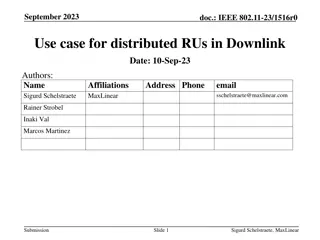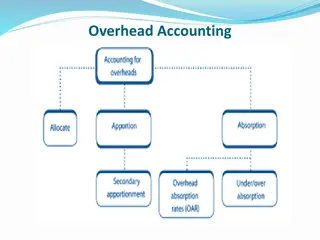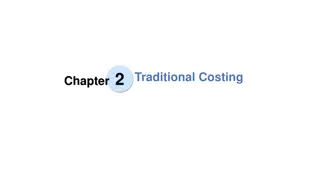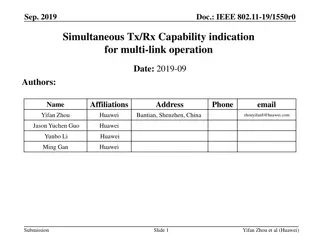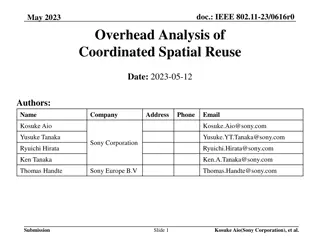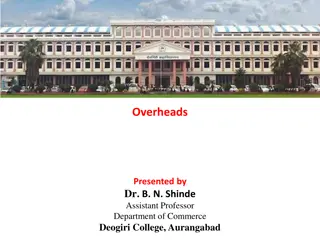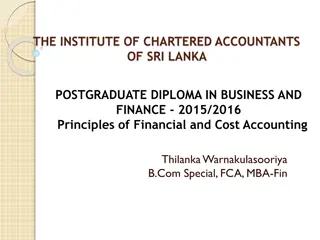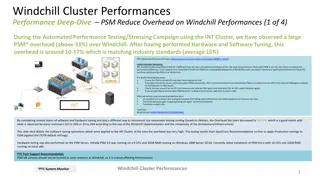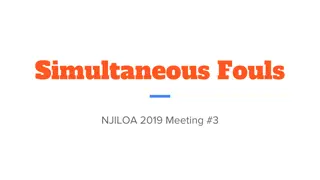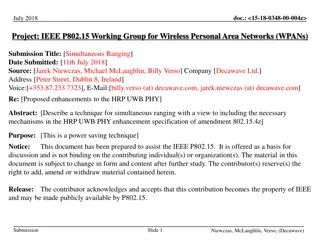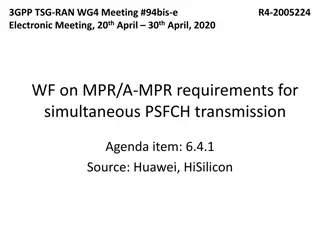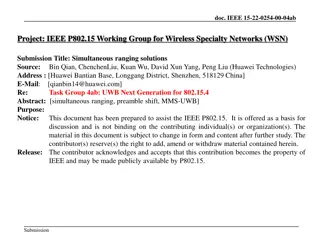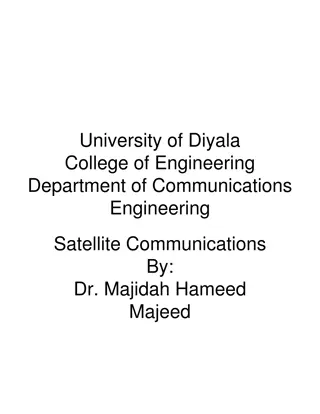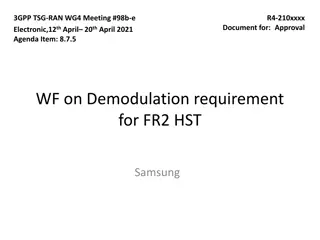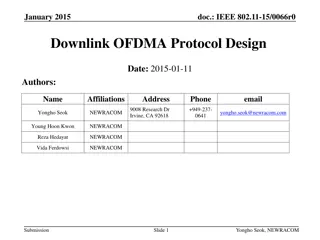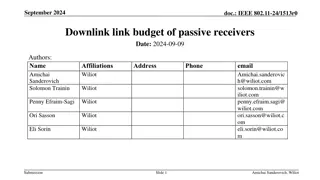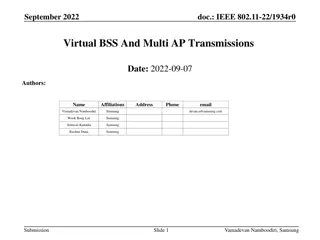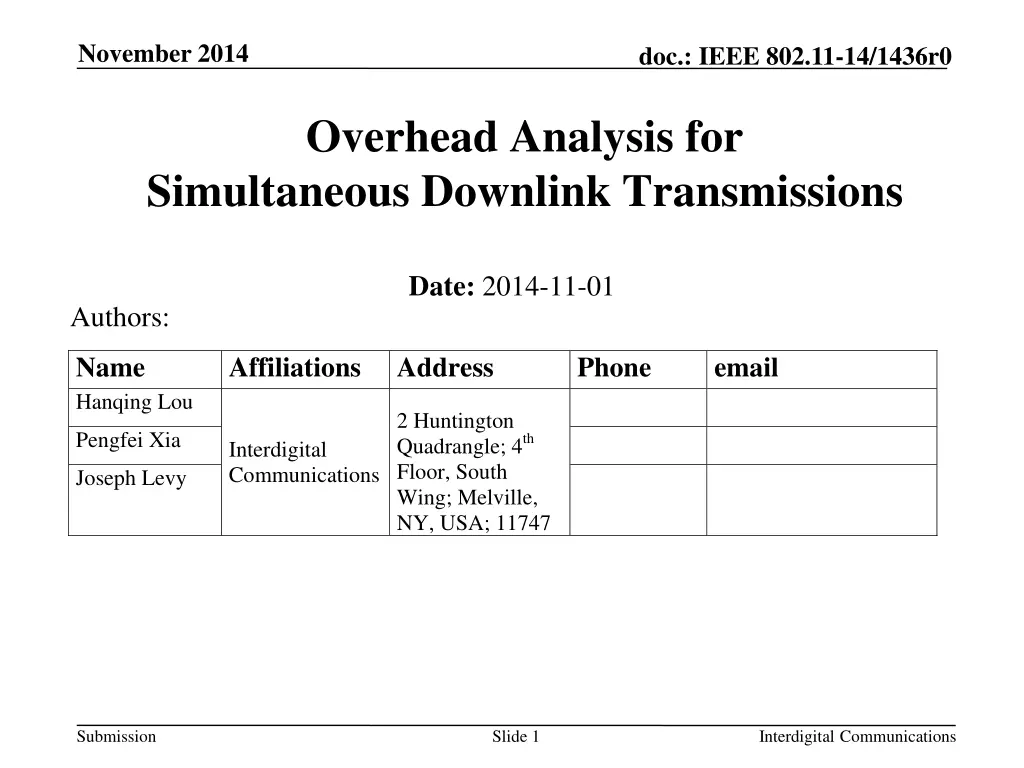
Analysis of IEEE 802.11 Transmission Overheads
Delve into a detailed analysis of transmission overheads in IEEE 802.11 networks, focusing on downlink simultaneous transmissions. Explore comparisons between various technologies such as OFDMA and DL MU-MIMO, including aspects like adaptive user selection and signaling overhead efficiency. Gain insights into small packet throughput considerations and the impact on different transmission scenarios.
Uploaded on | 2 Views
Download Presentation

Please find below an Image/Link to download the presentation.
The content on the website is provided AS IS for your information and personal use only. It may not be sold, licensed, or shared on other websites without obtaining consent from the author. If you encounter any issues during the download, it is possible that the publisher has removed the file from their server.
You are allowed to download the files provided on this website for personal or commercial use, subject to the condition that they are used lawfully. All files are the property of their respective owners.
The content on the website is provided AS IS for your information and personal use only. It may not be sold, licensed, or shared on other websites without obtaining consent from the author.
E N D
Presentation Transcript
November 2014 doc.: IEEE 802.11-14/1436r0 Overhead Analysis for Simultaneous Downlink Transmissions Date: 2014-11-01 Authors: Name Hanqing Lou Affiliations Address 2 Huntington Quadrangle; 4th Floor, South Wing; Melville, NY, USA; 11747 Phone email Pengfei Xia Interdigital Communications Joseph Levy Submission Slide 1 Interdigital Communications
November 2014 doc.: IEEE 802.11-14/1436r0 Abstract Downlink simultaneous transmissions is an important candidate technology in IEEE 802.11ax. Continuing our analysis in 1186r2, we perform a comparison of transmission overhead for downlink OFDMA, and DL MU-MIMO employing adaptive user selection and simultaneous ACK. We also perform a comparison of simultaneous ACK and staggered ACK signaling overhead for downlink OFDMA. Submission Slide 2 Interdigital Communications
September 2014 doc.: IEEE 802.11-14/1436r0 Comparison Methodology Link level PER simulation results MU-MIMO: ZF transmit beamforming per subcarrier OFDMA/SU: Single user transmit beamforming per subcarrier PER curve (Nt x Nr x Nu): 4 x 1 x 1 (single user transmit beamforming), 4 x 1 x 2, 4 x 1 x 3, 4 x 1 x 4 (zero forcing transmit beamforming) Sum throughput comparison For each SNR point, consider the maximum sum throughput (per user throughput x number of users) satisfying PER<=1% Determine the TXOP duration by taking into account the MCS, as well as signaling overhead: BA, BAR, SIFS, DIFS, ACK, backoff, etc. Fixed packet size and same varying SNR for all users Submission Slide 3 Interdigital Communications
September 2014 doc.: IEEE 802.11-14/1436r0 Analysis Parameters Four transmit antennas (AP), one receive antenna (STA) Control frame: MCS 0; Data frame: MCS 0~8 adaptive AMPDU aggregation: no; MSDU size: 36/1508 bytes [6] Number of simul. users: SU (1), OFDMA (4), MU-MIMO (1 ~ 4) MU-MIMO/SU Bandwidth: 20 MHz ( 52 data tones) OFDMA Bandwidth: 20 MHz total, 5 MHz (13 data tones) each user OFDMA/MU-MIMO: simultaneous ACK MU-MIMO: no impairments other than channel estimation noise, ideal user adaptation, no training/feedback overhead Parameter BA (bytes) BAR (bytes) ACK (bytes) Value 32 24 14 Parameter DIFS ( s) SIFS ( s) Avg backoff ( s) Value 34 16 27 Submission Slide 4 Interdigital Communications
November 2014 doc.: IEEE 802.11-14/1436r0 Small Packet Throughput Analysis OFDMA is suitable for small packet size transmissions MU-MIMO is highly penalized due to large signaling overhead Submission Slide 5 Interdigital Communications
November 2014 doc.: IEEE 802.11-14/1436r0 Large Packet Throughput Analysis MU-MIMO may provide certain gains More sensitive to channel impairments and user adaptation algo OFDMA may be combined with open-loop/closed-loop SU/MU-MIMO Submission Slide 6 Interdigital Communications
November 2014 doc.: IEEE 802.11-14/1436r0 Different ACK Options Staggered ACK Also known as channel based ACK [9] Same as that for DL MU-MIMO in 802.11ac Baseline ACK scheme Data PPDU (AP -> STA 1) Block ACK Request PPDU (AP -> STA 2) Block ACK Request PPDU (AP -> STA 3) Block ACK Request PPDU (AP -> STA 4) Block ACK PPDU (STA1-> AP) Block ACK PPDU (STA2-> AP) Block ACK PPDU (STA3-> AP) Block ACK PPDU (STA4-> AP) Data PPDU (AP -> STA 2) Data PPDU (AP -> STA 3) Data PPDU (AP -> STA 4) Simultaneous ACK Also known as subchannel based ACK [9] Multiple ACK transmitted simultaneously in the freq domain Each ACK occupies the same channel resource block as the data BlockACK STA1-> AP Data PPDU (AP -> STA 1) BlockACK STA2-> AP Data PPDU (AP -> STA 2) BlockACK STA3-> AP Data PPDU (AP -> STA 3) BlockACK STA4-> AP Data PPDU (AP -> STA 4) Interdigital Communications Submission Slide 7
November 2014 doc.: IEEE 802.11-14/1436r0 ACK Overhead Analysis for DL OFDMA Scheme ( 4 users) Staggered ACK Simultaneous ACK Overhead 648 s 128 s Significant throughput enhancement from simultaneous ACK Similarly, simultaneous ACK may be considered for DL MU-MIMO Submission Slide 8 Interdigital Communications
November 2014 doc.: IEEE 802.11-14/1436r0 Conclusion DL MU-MIMO Suitable for large packets and high SNR May suffer from a large feedback overhead DL OFDMA Potential efficiency improvement over single user transmissions Suitable for small packet transmissions ACK Simultaneous ACK may reduce overhead and improve the throughput substantially Submission Slide 9 Interdigital Communications
November 2014 doc.: IEEE 802.11-14/1436r0 References 1. 2. 3. 4. 5. IEEE 802.11-14/0839r1, Discussion on OFDMA in IEEE 802.11ax, Jinsoo Ahn, July 2014. IEEE 802.11-13/1382r0, Discussion on OFDMA in HEW, Jinsoo Choi et. al., November 2013. IEEE 802.11-14/0804r1, Envisioning 11ax PHY Structure - Part I, Jinsoo Choi et. al., July 2014. IEEE 802.11-14/0801r0, Envisioning 11ax PHY Structure - Part II, Jinsoo Choi et. al., July 2014. IEEE 802.11-13/1395r2, Simultaneous Transmission Technologies for HEW, Koichi Ishihara et. al., November 2013. IEEE 802.11-14/0571r3, Evaluation Methodology, Ron Porat et. al., July 2014. G. Bianchi, Performance analysis of the IEEE 802.11 distributed coordination function, IEEE JSAC, vol. 18, no. 3, August 2000. IEEE 802.11-14/0980r2, Simulation Scenarios, Simone Merlin et. al., July 2014. IEEE 802.11-14/1211r0, ACK procedure for OFDMA, Yongho Seok et. al., September 2014. IEEE 802.11-12/0103r0, Sequence detection for parallel ACK, T. Kim et. al., Jan. 2012. IEEE 802.11-14/1186r2, Comparisons of Simultaneous Downlink Transmissions, P. Xia et. al., Sept. 2014. 6. 7. 8. 9. 10. 11. Submission Slide 10 Pengfei Xia, Interdigital Communications


